ssm:springmvc、spring、mybatis这三个框架的整合,有耐心一步步走。
--WZY
一、SSM框架整合
1.1、整合思路
从底层整合起,也就是先整合mybatis与spring,然后在编写springmvc。
1.2、开发需求
查询商品列表(从数据库中查询)
1.3、创建web工程

现在ssm的工程创建就有区别于原先的dao、service、web这样的三层目录了,现在是mapper、service、controller这样的目录,mapper就相当于以前的dao、controller相当于以前的web,改变了名称而已。不要因此看不懂了。
1.4、添加jar包
这种jar包,上网直接百度ssm整合的jar包即可
数据库驱动、Mybatis的核心、依赖包、Mybatis与spring的整合包、Dbcp连接池包、Spring的包(包括springmvc的包)、Aop的依赖包、Jstl包、Common-logging包
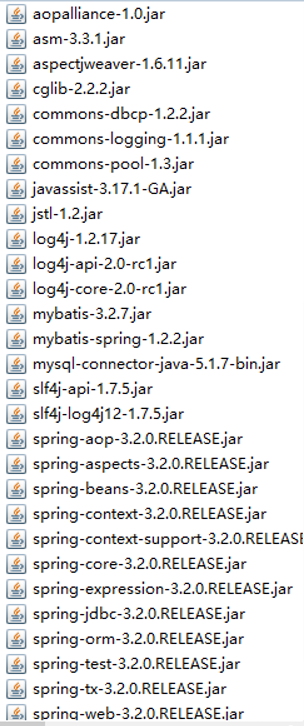
1.5、开始整合mapper(mybatis与spring的整合)
详细的整合思路讲解:mybatis与spring的整合 这里我直接上代码。步骤
1.5.1、SqlMapConfig.xml
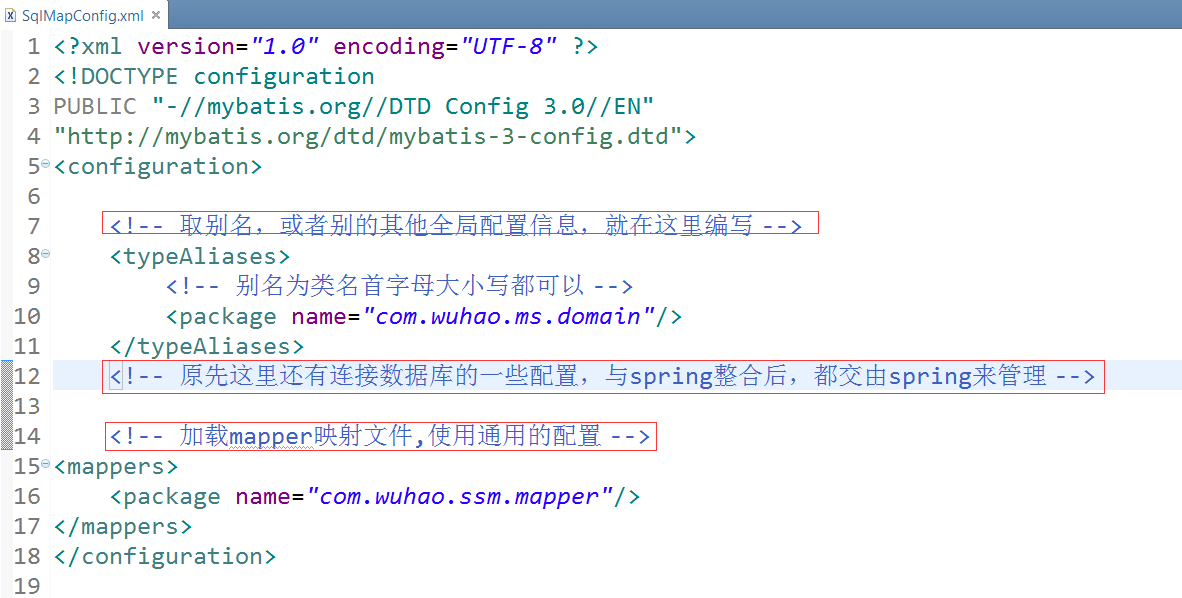

<?xml version="1.0" encoding="UTF-8" ?> <!DOCTYPE configuration PUBLIC "-//mybatis.org//DTD Config 3.0//EN" "http://mybatis.org/dtd/mybatis-3-config.dtd"> <configuration> <!-- 取别名,或者别的其他全局配置信息,就在这里编写 --> <typeAliases> <!-- 别名为类名首字母大小写都可以 --> <package name="com.wuhao.ms.domain"/> </typeAliases> <!-- 原先这里还有连接数据库的一些配置,与spring整合后,都交由spring来管理 --> <!-- 加载mapper映射文件,使用通用的配置 --> <mappers> <package name="com.wuhao.ssm.mapper"/> </mappers> </configuration>
1.5.2、applicationContext-dao.xml的配置
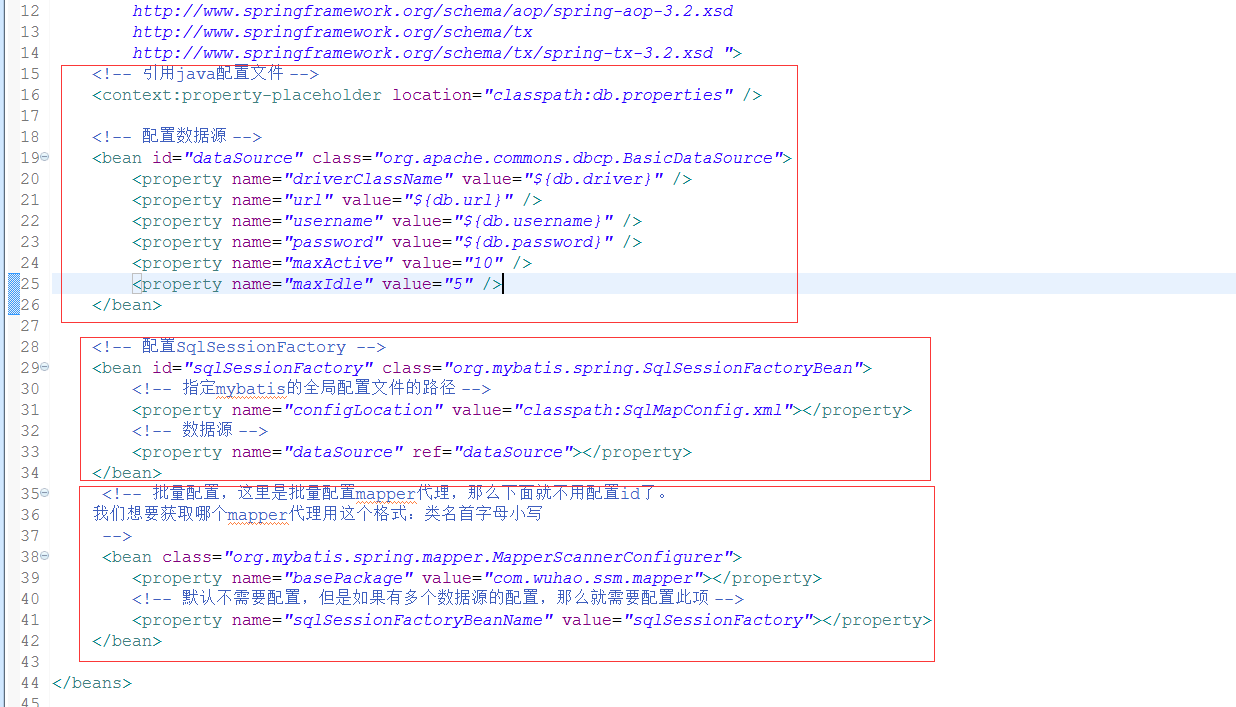
这里需要注意一点,在指定mybatis的全局配置文件的路径的时候,也就是在value="classpath:SqlMapConfig.xml"时,如果在创建的config的配置文件目录下还有层级目录,则这里需要加上,比如,config下面分为了mybatis和spring,那么这里就需要写value="classpath:mybatis/SqlMapConfig.xml",看根据你自己的需求来编写


<beans xmlns="http://www.springframework.org/schema/beans" xmlns:xsi="http://www.w3.org/2001/XMLSchema-instance" xmlns:mvc="http://www.springframework.org/schema/mvc" xmlns:context="http://www.springframework.org/schema/context" xmlns:aop="http://www.springframework.org/schema/aop" xmlns:tx="http://www.springframework.org/schema/tx" xsi:schemaLocation="http://www.springframework.org/schema/beans http://www.springframework.org/schema/beans/spring-beans-3.2.xsd http://www.springframework.org/schema/mvc http://www.springframework.org/schema/mvc/spring-mvc-3.2.xsd http://www.springframework.org/schema/context http://www.springframework.org/schema/context/spring-context-3.2.xsd http://www.springframework.org/schema/aop http://www.springframework.org/schema/aop/spring-aop-3.2.xsd http://www.springframework.org/schema/tx http://www.springframework.org/schema/tx/spring-tx-3.2.xsd "> <!-- 引用java配置文件 --> <context:property-placeholder location="classpath:db.properties" /> <!-- 配置数据源 --> <bean id="dataSource" class="org.apache.commons.dbcp.BasicDataSource"> <property name="driverClassName" value="${db.driver}" /> <property name="url" value="${db.url}" /> <property name="username" value="${db.username}" /> <property name="password" value="${db.password}" /> <property name="maxActive" value="10" /> <property name="maxIdle" value="5" /> </bean> <!-- 配置SqlSessionFactory --> <bean id="sqlSessionFactory" class="org.mybatis.spring.SqlSessionFactoryBean"> <!-- 指定mybatis的全局配置文件的路径 --> <property name="configLocation" value="classpath:SqlMapConfig.xml"></property> <!-- 数据源 --> <property name="dataSource" ref="dataSource"></property> </bean> <!-- 批量配置,这里是批量配置mapper代理,那么下面就不用配置id了。 我们想要获取哪个mapper代理用这个格式:类名首字母小写 --> <bean class="org.mybatis.spring.mapper.MapperScannerConfigurer"> <property name="basePackage" value="com.wuhao.ssm.mapper"></property> <!-- 默认不需要配置,但是如果有多个数据源的配置,那么就需要配置此项 --> <property name="sqlSessionFactoryBeanName" value="sqlSessionFactory"></property> </bean> </beans>
1.5.3、db.properties配置


db.driver=com.mysql.jdbc.Driver db.url=jdbc:mysql://localhost:3306/test?useUnicode=true&characterEncoding=utf8 db.username=root db.password=root
1.5.4、开发mapper,将逆向工程生成的添加进来
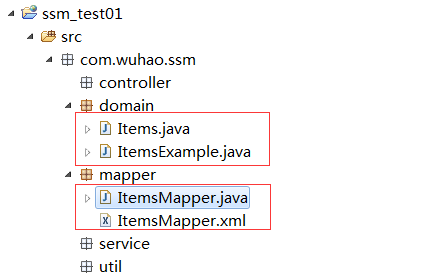
注意:Mapper开发时,先要根据需求进行分析,是否匹配逆向工程生成的代码,如果匹配成功,则不需要再开发mapper;如果不匹配,再去扩展一个新的mapper接口和mapper映射文件来处理该需求,通俗点讲,就是逆向工程生成的mapper接口中的定义的功能是否满足我们开发的需求,因为逆向工程生成的都是对于单表进行操作的,而我们有时候需要的是更复杂的查询,所以如果有需要我们在自己创建mapper接口和mapper映射文件,其实就是扩展功能。
1.6、整合service
添加applicationContext-service.xml配置文件,用来处理事务,
applicationContext-service.xml:如果不懂其中的代码的意思,就查看之前讲解spring管理事务的文章。这里直接复制粘帖即可,修改一些包名称等
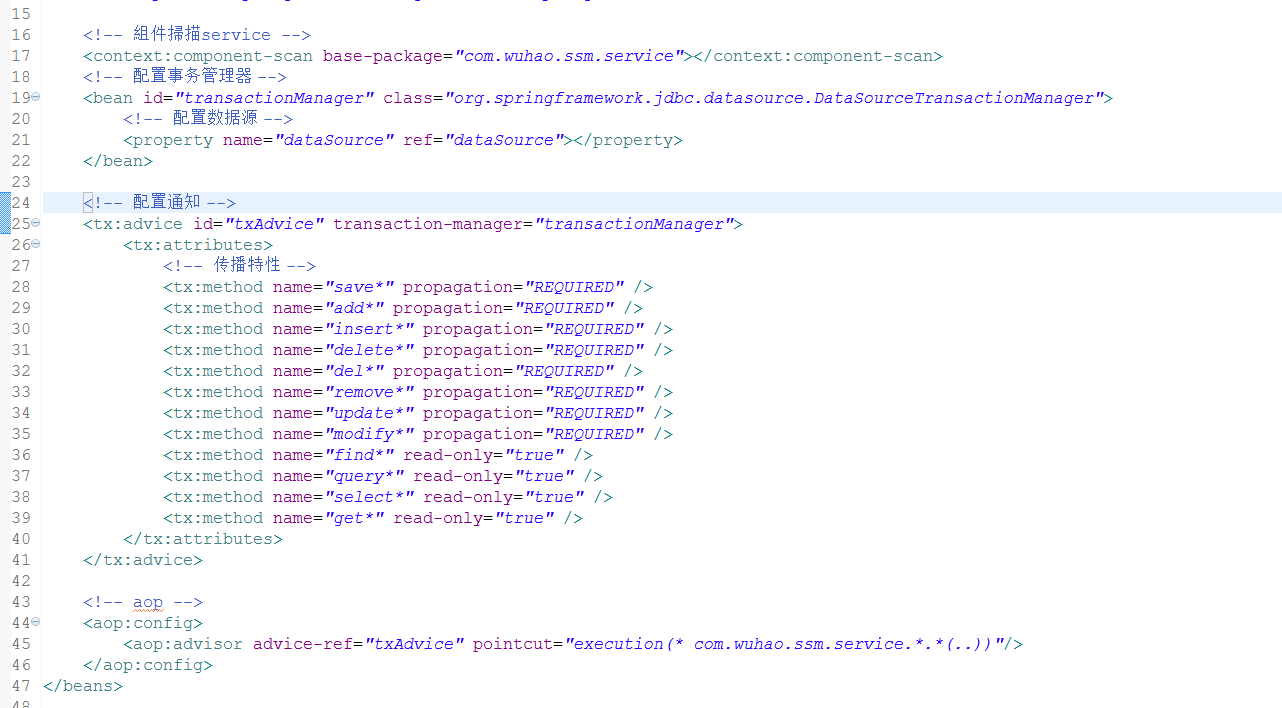

<beans xmlns="http://www.springframework.org/schema/beans" xmlns:xsi="http://www.w3.org/2001/XMLSchema-instance" xmlns:mvc="http://www.springframework.org/schema/mvc" xmlns:context="http://www.springframework.org/schema/context" xmlns:aop="http://www.springframework.org/schema/aop" xmlns:tx="http://www.springframework.org/schema/tx" xsi:schemaLocation="http://www.springframework.org/schema/beans http://www.springframework.org/schema/beans/spring-beans-3.2.xsd http://www.springframework.org/schema/mvc http://www.springframework.org/schema/mvc/spring-mvc-3.2.xsd http://www.springframework.org/schema/context http://www.springframework.org/schema/context/spring-context-3.2.xsd http://www.springframework.org/schema/aop http://www.springframework.org/schema/aop/spring-aop-3.2.xsd http://www.springframework.org/schema/tx http://www.springframework.org/schema/tx/spring-tx-3.2.xsd "> <!-- 組件掃描service --> <context:component-scan base-package="com.wuhao.ssm.service"></context:component-scan> <!-- 配置事务管理器 --> <bean id="transactionManager" class="org.springframework.jdbc.datasource.DataSourceTransactionManager"> <!-- 配置数据源 --> <property name="dataSource" ref="dataSource"></property> </bean> <!-- 配置通知 --> <tx:advice id="txAdvice" transaction-manager="transactionManager"> <tx:attributes> <!-- 传播特性 --> <tx:method name="save*" propagation="REQUIRED" /> <tx:method name="add*" propagation="REQUIRED" /> <tx:method name="insert*" propagation="REQUIRED" /> <tx:method name="delete*" propagation="REQUIRED" /> <tx:method name="del*" propagation="REQUIRED" /> <tx:method name="remove*" propagation="REQUIRED" /> <tx:method name="update*" propagation="REQUIRED" /> <tx:method name="modify*" propagation="REQUIRED" /> <tx:method name="find*" read-only="true" /> <tx:method name="query*" read-only="true" /> <tx:method name="select*" read-only="true" /> <tx:method name="get*" read-only="true" /> </tx:attributes> </tx:advice> <!-- aop --> <aop:config> <aop:advisor advice-ref="txAdvice" pointcut="execution(* com.wuhao.ssm.service.*.*(..))"/> </aop:config> </beans>
1.7、整合controller
也就是使用springmvc了。非常简单。
1.7.1、在web.xml中配置前端控制器DispatcherServlet
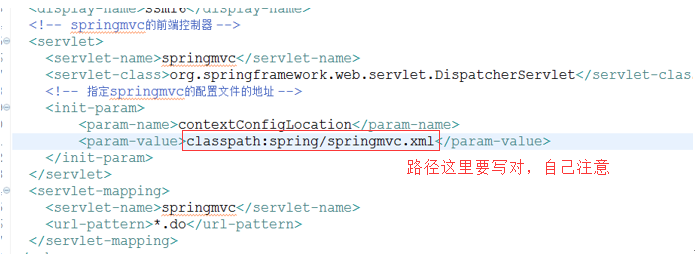

<!-- springmvc 的前端控制器 -->
<servlet>
<servlet-name>springmvc</servlet-name>
<servlet-class>org.springframework.web.servlet.DispatcherServlet</servlet-class>
<!-- 指定springmvc的配置文件的地址 -->
<init-param>
<param-name>contextConfigLocation</param-name>
<param-value>classpath:spring/springmvc.xml</param-value>
</init-param>
</servlet>
<servlet-mapping>
<servlet-name>springmvc</servlet-name>
<!-- 这里有三种配置url-pattern方案
1、*.do:后缀为.do的请求才能够访问到该servlet[用这个]
2、/ :所有请求都能够访问到该servlet(除jsp),包括静态请求(处理会有问题,不用)
3、/* :有问题,因为访问jsp也会到该servlet,而访问jsp时,我们不需要这样,也不用
-->
<url-pattern>*.do</url-pattern>
</servlet-mapping>
1.7.2、配置springmvc.xml


<beans xmlns="http://www.springframework.org/schema/beans" xmlns:xsi="http://www.w3.org/2001/XMLSchema-instance" xmlns:mvc="http://www.springframework.org/schema/mvc" xmlns:context="http://www.springframework.org/schema/context" xmlns:aop="http://www.springframework.org/schema/aop" xmlns:tx="http://www.springframework.org/schema/tx" xsi:schemaLocation="http://www.springframework.org/schema/beans http://www.springframework.org/schema/beans/spring-beans-3.2.xsd http://www.springframework.org/schema/mvc http://www.springframework.org/schema/mvc/spring-mvc-3.2.xsd http://www.springframework.org/schema/context http://www.springframework.org/schema/context/spring-context-3.2.xsd http://www.springframework.org/schema/aop http://www.springframework.org/schema/aop/spring-aop-3.2.xsd http://www.springframework.org/schema/tx http://www.springframework.org/schema/tx/spring-tx-3.2.xsd "> <!-- 扫描 --> <context:component-scan base-package="com.wuhao.ssm.controller"></context:component-scan> <!-- 配置处理器映射器和处理器适配器 --> <mvc:annotation-driven /> <!-- 配置视图解析器 --> <bean class="org.springframework.web.servlet.view.InternalResourceViewResolver"> <property name="prefix" value="/WEB-INF/jsp/"></property> <property name="suffix" value=".jsp"></property> </bean> </beans>
1.8、整合spring配置文件
就是将所有的spring的配置文件都进行加载启动。也就是在web.xml中配置spring的监听器


<!-- 加载spring容器 -->
<!-- 配置监听器,用于加载spring 配置文件 -->
<context-param>
<param-name>contextConfigLocation</param-name>
<param-value>classpath:applicationContext-*.xml</param-value>
</context-param>
<listener>
<listener-class>org.springframework.web.context.ContextLoaderListener</listener-class>
</listener>
1.9、总结所有的配置如下图
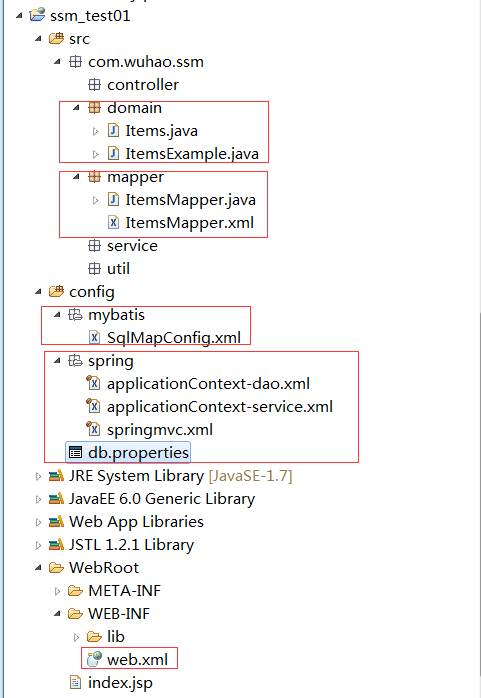
1.10、部署测试
1.10.1、查询商品列表(从数据库中查询)
1、编写service层
ItemsService 接口

ItemsServiceImpl 实现类 不使用注解开发
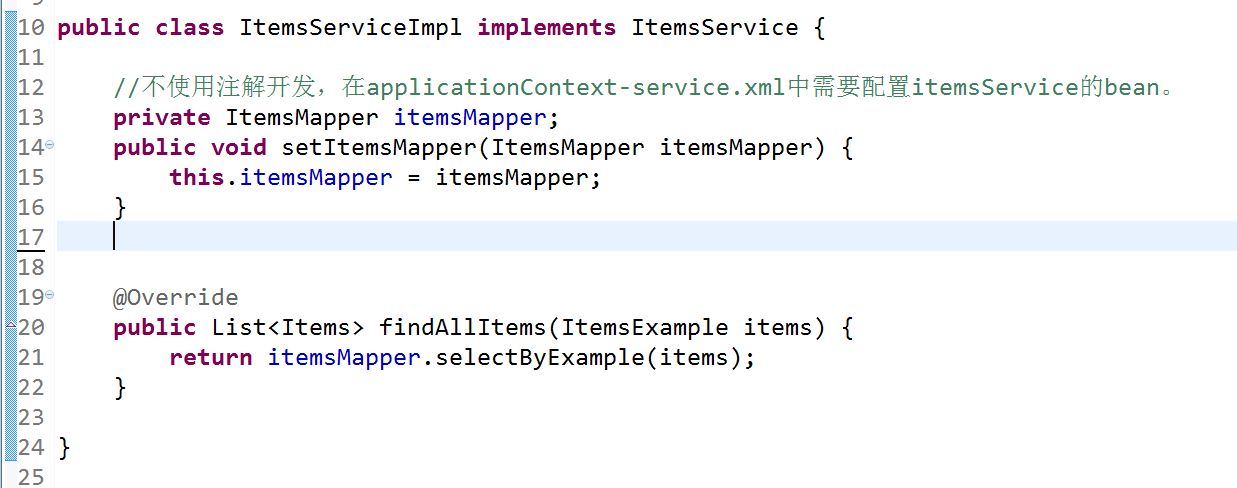
applicationContext-service.xml中配置该service的bean

ItemsServiceImpl 实现类 使用注解的话,就不需要在applicationContext-service.xml中配置该service的bean了

2、编写controller层
该层的编写有很多中方式,我记得前一节讲解过,比如实现Controller接口,使用注解等,一般直接使用注解。
ItemsController

3、添加jsp页面
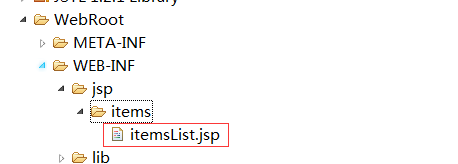

<%@ page language="java" contentType="text/html; charset=UTF-8" pageEncoding="UTF-8"%> <%@ taglib uri="http://java.sun.com/jsp/jstl/core" prefix="c" %> <%@ taglib uri="http://java.sun.com/jsp/jstl/fmt" prefix="fmt"%> <!DOCTYPE html PUBLIC "-//W3C//DTD HTML 4.01 Transitional//EN" "http://www.w3.org/TR/html4/loose.dtd"> <html> <head> <meta http-equiv="Content-Type" content="text/html; charset=UTF-8"> <title>查询商品列表</title> </head> <body> <form action="${pageContext.request.contextPath }/item/queryItem.action" method="post"> 查询条件: <table width="100%" border=1> <tr> <td><input type="submit" value="查询"/></td> </tr> </table> 商品列表: <table width="100%" border=1> <tr> <td>商品名称</td> <td>商品价格</td> <td>生产日期</td> <td>商品描述</td> <td>操作</td> </tr> <c:forEach items="${itemsList }" var="item"> <tr> <td>${item.name }</td> <td>${item.price }</td> <td><fmt:formatDate value="${item.createtime}" pattern="yyyy-MM-dd HH:mm:ss"/></td> <td>${item.detail }</td> <td><a href="${pageContext.request.contextPath }/editItems.do?id=${item.id}">修改</a></td> </tr> </c:forEach> </table> </form> </body> </html>
4、测试
http://localhost:8080/ssm_test01/queryItems.do 如下图,即成功

二、总结
这样,ssm的框架整合就结束了,非常简单,按步骤,先整合mybatis与spring,然后在整合springmvc。自己练习几遍就会了。接下来的文章就会以此为基础,讲解springmvc的各种小功能,比如,springmvc的参数绑定、springmvc的校验器,图片的上传等。
